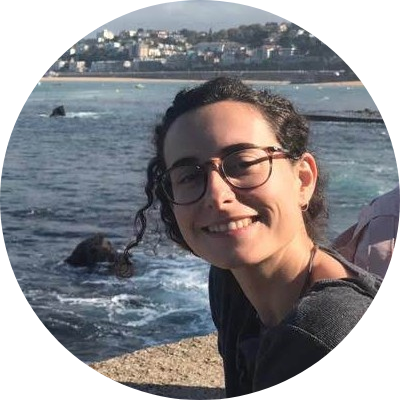Laia Casamiquela
Astronome-Adjointe
LIRA, Observatoire de Paris
About Me

I am astronomer (astronome-adjointe) at the Observatory of Paris (LIRA laboratory, Meudon section). My research activities fall within the topics of stellar and Galactic physics. I obtained my PhD in physics in 2017 in the University of Barcelona, where I led the OCCASO survey, dedicated to study the properties of the open cluster population of our Galaxy. My studies are centered on the analysis of the spectra of stars of the Milky Way, to obtain a detailed description of stars, in particular of their chemical abundances and ages. My main interest is to understand the origin and history of the different components of the Milky Way making use of this detailed chemical description coupled with the ultra-high precision dynamical information provided by the Gaia satellite. In turn, this detailed data of stars allows us to push the limits of our understanding of stellar structure and evolution.
I also enjoy taking part in outreach activities such as conferences and public telescope observations. I am particularly proud of leading an outreach/educational project in the program Youth and Science for the past 8 years and counting. The project aims at encouraging scientific-technological vocations of teenagers with talent and interest in astrophysics. I am also co-author of the outreach book "Finestres al cel: teoria, observacions i simulacions per entendre l'Univers" published in 2023.
Thanks to the MW-Gaia COST Action I have made a compilation of the publicly available resources for stellar spectroscopists, including radiative transfer codes, packages for measuring atmospheric parameters and chemical abundances and linelists. You can check it out here!
Research
Open Clusters
They are gravitationally bound groups of stars formed from the same cloud of gas and dust, thus having the same age and chemical composition. Most stars, including the Sun, are believed to be formed in clusters although most of them are dissolved in the first few milion years. Clusters are fundamental objects which I have used as tracers of the evolution of the disk of our Galaxy, and to study processes not well understood in stellar physics.
Reference stars for spectroscopy
In the era of large scale stellar surveys and machine learning techniques, it is essential to have inter-calibration samples of stars for which we have an accurate and precise description of their stellar atmospheres. I am in charge of the spectroscopic analysis of the Gaia FGK benchmark stars, which represent the fundamental calibrators for stellar and Galactic surveys. These stars represent the result of the effort invested in some the latest technological advancements in astronomy (such as interferometry or asteroseismology).
Galactic Archaeology
”Galactic archaeologists” aim to decrypt the information locked into the chemical composition of stars coupled with their ages and kinematics, to trace the history of our Galaxy. This can be done using the very precise dynamical data from Gaia together with detailed information from spectroscopic studies.
Participation in consortiums
I am a member of the Gaia Data Processing and Analysis Consortium (DPAC), participating in the CU8 unit. My contribution is centered on the validation of chemical abundances, and the implementation of a Bayesian method to compute physical parameters of stars. I also participate in the WEAVE and 4MOST consortiums, where I contribute in the target list selection for the Galactic archaeology survey, and the calibration sample.
CV & Publications
First author publications:
- Casamiquela, L. et al. (2016) The OCCASO survey: presentation and radial velocities of 12 Milky Way open clusters MNRAS, 458, 3
- Casamiquela, L. et al. (2017) OCCASO - II. Physical parameters and Fe abundances of red clump stars in 18 open clusters MNRAS, 470, 4
- Casamiquela, L. et al. (2018) NGC 6705 a young α-enhanced open cluster from OCCASO data A&A, 610, A66
- Casamiquela, L. et al. (2019) OCCASO - III. Iron peak and α elements of 18 open clusters. Comparison with chemical evolution models and field stars MNRAS, 490, 2
- Casamiquela, L. et al. (2020) Differential abundances of open clusters and their tidal tails: Chemical tagging and chemical homogeneity A&A, 635, A8
- Casamiquela, L. et al. (2021) Abundance-age relations with red clump stars in open clusters A&A, 652, A25
- Casamiquela, L. et al. (2021) The (im)possibility of strong chemical tagging A&A, 654, A151
- Casamiquela, L. et al. (2022) Unravelling UBC 274: A morphological, kinematical, and chemical analysis of a disrupting open cluster A&A, 664, A31
- Casamiquela, L. et al. (2022) Chemically Peculiar Stars in the Open Cluster Stock 2 AJ 164 6 255
- Casamiquela, L. et al. (2024) New stellar age estimates using SPInS based on Gaia DR3 photometry and LAMOST DR8 abundances A&A, 692, A243
Experience
LIRA (previously GEPI) Observatoire de Paris Meudon, PSL University
Astronome-adjointeInstitut de Ciències del Cosmos, Universitat de Barcelona
Ramón y Cajal fellowshipGEPI, Observatoire de Paris, PSL University
Postdoc fellowshipLaboratoire d'Astrophysique de Bordeaux, CNES
Postdoc fellowshipLaboratoire d'Astrophysique de Bordeaux, CNRS
Postdoc contractInstitut de Ciències del Cosmos, Universitat de Barcelona
PhD studies. "Chemical and dynamical analysis of Open Clusters in the context of the Milky Way disc"April 2014 – June 2017
Read MoreUniversitat de Barcelona
Master in Astrophysics, Particle Physics and CosmologyOctober 2012 – June 2013

